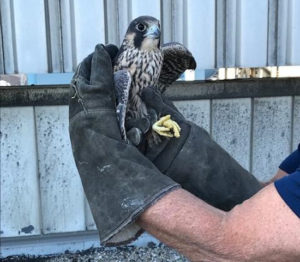Kristen LeForce of DTE’s Environmental Management & Resources team wears many hats, including “adoption agent” for peregrine falcons.
She recently arranged for a peregrine falcon chick to join a new family at DTE’s Monroe Power Plant after it was rejected and attacked by its biological parents.
“I learned of a chick that lived at a General Motors (GM) site that was injured and taken to a rehabilitation facility,” LeForce said. “Upon re-introducing the chick to its nest, the parents acted aggressively toward the chick. The parents didn’t recognize it since it was nearly fully-grown, and all their other chicks had left the nest.”
LeForce leveraged her professional connections to engage with her counterpart at GM and renowned Licensed Wildlife Rehabilitator Dave Hogan. LeForce presented the idea of relocating the chick to Monroe Power Plant, where she knew of a falcon family that suffered recent tragedy and may be receptive to adopting the chick, which they named Blaze.
“The family lost two of their three chicks so they were still in parent mode and doing things like feeding babies,” she said. “We all agreed it was a good idea, so Hogan brought Blaze to the plant.”
Blaze initially lived in a covered structure so the mother could not attack her. The goal was to slowly acquaint them and encourage them to talk to each other and see if the mother bird would try to feed Blaze.
DTE’s Tom Foxworthy and the Monroe Power Plant’s summer students monitored Blaze’s interactions with prospective adoptive parents to make sure they were getting along. They also fed and took care of her for three days.
The telltale sign the adoption may be a success was the parents acting aggressive, like chirping and swooping, toward people and being protective of Blaze.
Since the birds were behaving the way the wildlife rescue team wanted, they freed Blaze from her structure where she immediately joined her new family. To the rescue team’s delight, the mother falcon continued to demonstrate protective behavior.
While Blaze may have been nearly fully grown, the adoption was still critical to her survival.
“Blaze still needs to learn life skills like hunting and how to properly fly,” LeForce said. “The mom and dad will teach her that.”
It was an eventful year for the falcon family at Monroe Power Plant. The adoptive parents originally had three chicks, but one died in the nest shortly after birth and the other two fell from the nest and broke their wings. Unable to recover properly, one of the chicks unfortunately had to be euthanized. The other chick, named Ryan by the staff at Monroe, was able to heal properly after being treated by a vet and was released at the plant last week. He now lives comfortably with his new sister, learning how to be falcons together.
Peregrine falcons are cliff nesters so they nest on sides of bridges and large buildings, which makes the Monroe Power Plant an ideal location for habitats. The plant voluntarily puts up protective netting around the nest, but the chicks don’t always land where predicted. And even then, the fall into the net can cause damage if they land awkwardly. The plant’s staff works quickly to rescue chicks that fall into the net.
The Michigan Department of Natural Resources has been monitoring breeding peregrine falcons at Monroe Power Plant for the past 20 years to help the population of a bird that was nearly extinct in the U.S. in the 1970s.
The population was shrinking because of the effects of DDT and other persistent pesticides, which caused falcon eggs to have thin shells that shattered when mothers sat on them for incubation. In addition, 60% of peregrine falcons don’t survive their first year because they’re unsuccessful at hunting, or crash when swooping on prey.
Today, the population is steady and there are an estimated 1,650 breeding pairs in North America. An adult peregrine falcon is one of the world’s fastest birds – flying up to 200 miles per hour – and preying on other birds in the sky, mainly pigeons.
